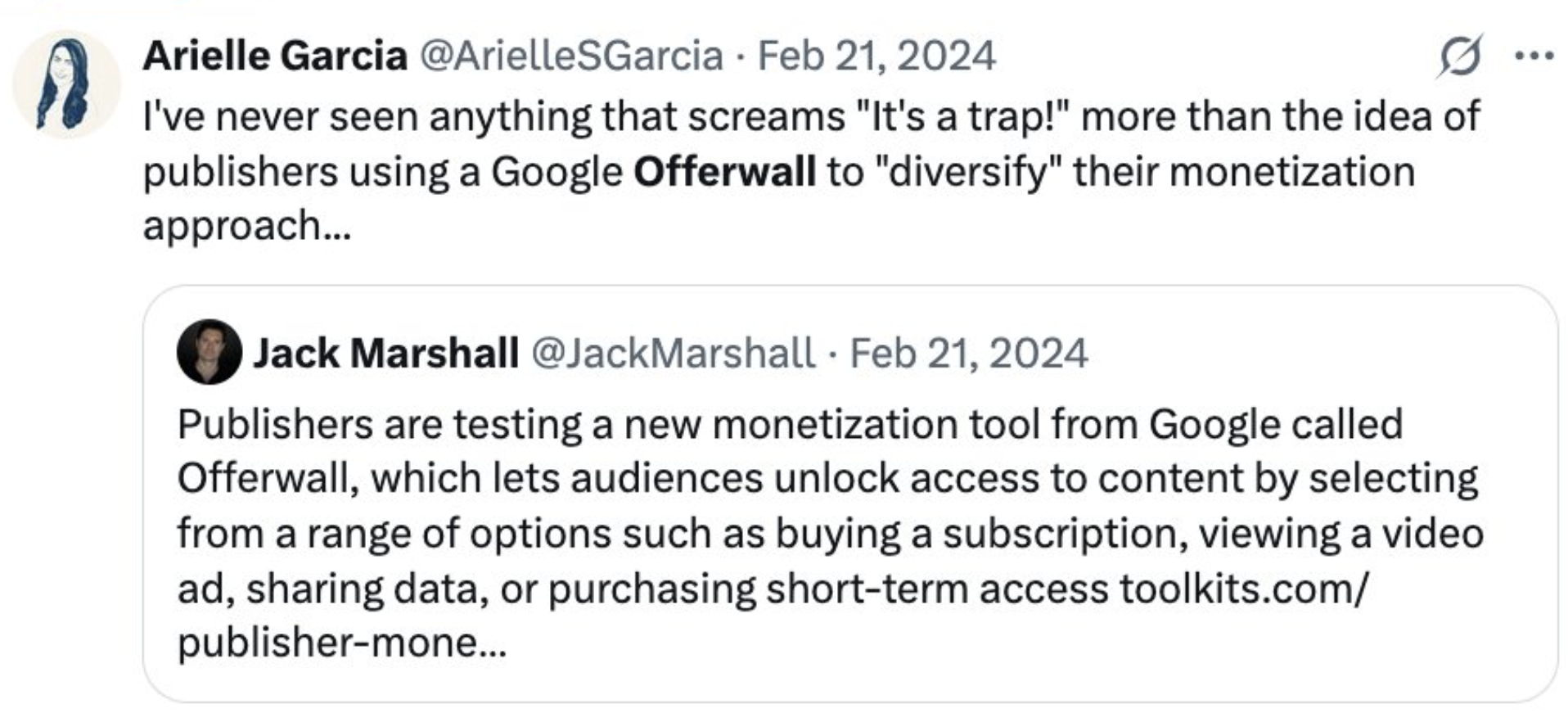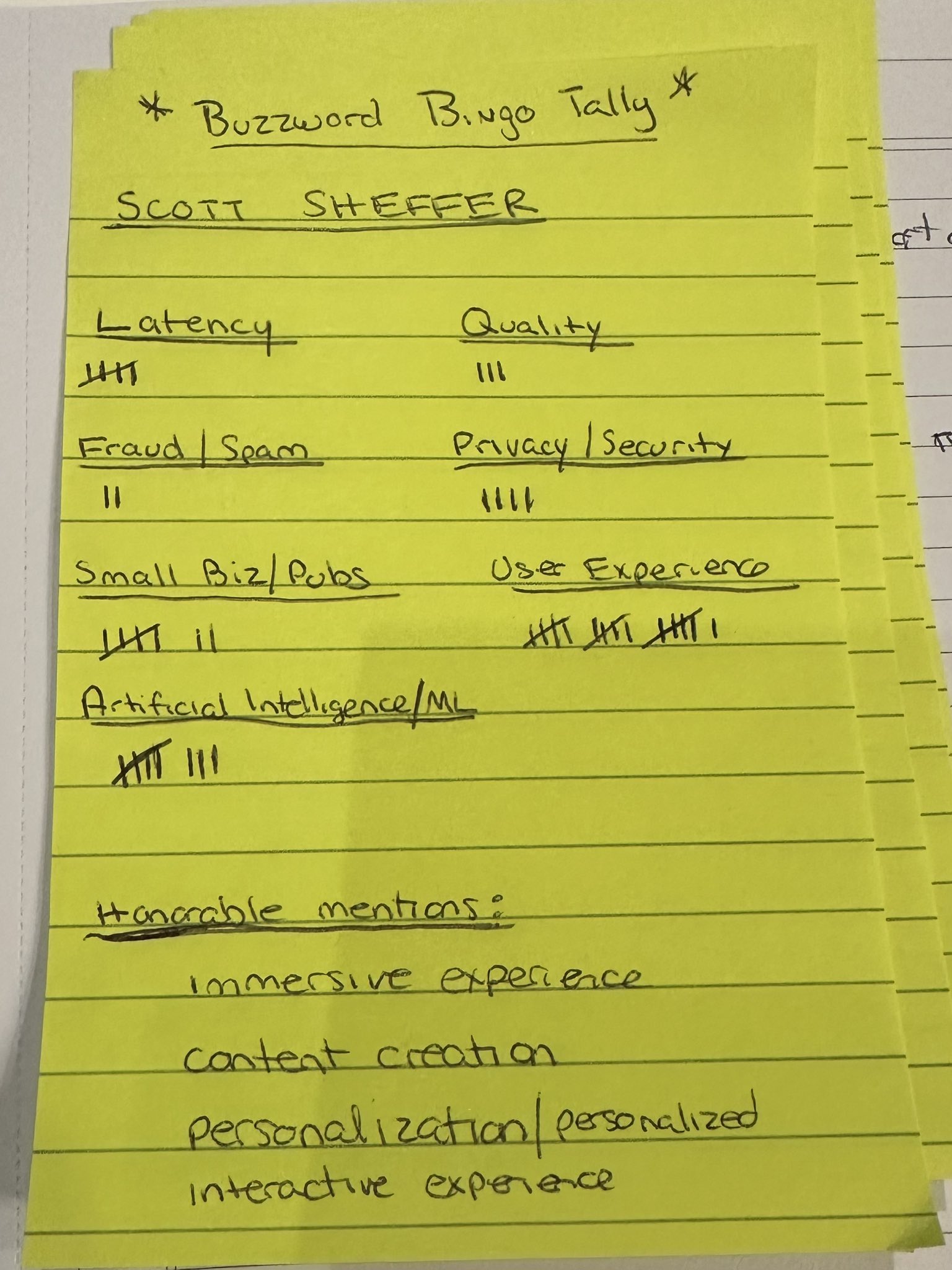Remedies Trial Update, September 29, 2025: Buzzword bingo is back as Google begins its case in chief
November 21, 2025

Day 6 of US v. Google adtech remedies began with Google’s motion to exclude Equative CEO, Arnaud Creput’s testimony on how the French competition authority’s remedies in their settlement with Google have changed things for publishers. Judge Brinkema mostly denied the motion, except as to hearsay.
Arnaud Creput, Equative CEO
Given the Judge’s ruling on the motion, Creput couldn’t answer questions about how it impacted publishers, which alongside various technical issues, threw a bit of a wrench in the DOJ’s plan for his testimony. Still, he explained two important things. First, he explained that the French remedies did not change anything for Equative, and its ad server business in particular. Second, he explained that Equative’s ad server and ad exchange, while integrated, would not be that difficult to separate. On cross-examination, Google walked through several dependencies that the ad server has - a database system, query system, processing system, privacy infrastructure, event logging, machine learning, etc. They were trying to make divestiture seem very complicated, but in my view, all they landed is that most of these dependencies are general purpose systems just like DOJ’s technical experts said they were.
Dr. Goranka Bjedov, Technical Timeline Feasibility Expert
Google resumed cross-examination by ending it, passing the witness to DOJ for redirect. Nothing to report here, other than on redirect we got a peek at a less-redacted, previously-sealed Exhibit PRX108 which included internal Google analysis of moving ads to Google Cloud Platform, and noted in part “migration costs should be very low.”
DOJ rested their case pending two witnesses that will testify tomorrow - Noam Wolf, Sr. Director of Engineering at Google and Rajeev Goel, CEO at Pubmatic.
Scott Sheffer, VP, Global Partnerships, Sell-side Monetization @ Google
Google again called Scott Sheffer as their first witness. He famously brought us the adtech spaghetti football during liabilities, and is back with more weaponized complexity and jazz hands.
Sheffer talks about how the GAM team is integrated across AdX and DfP. He talks about various other publisher products not part of the case, like Offerwall and Ad Intents. On Offerwall, he explains it has just recently (June 2025) become generally available and allows publishers to offer other options for users to access content like micropayments, or watching an ad in exchange for a reward.

I’ve spoken before about how I think it would be nuts for publishers to use Google’s solution here versus independent versions of similar tech in the name of revenue diversification - particularly as I imagine it allows Google to further siphon value in the form of publisher audience data. Naturally, Google positions it as a benevolent example of publisher-focused innovation.
Sheffer says that GAM has customers across 163 or 164 countries, with 81% outside of the US. He explains that not all GAM publishers transact open-web display. He overcomplicates the migration process publishers themselves would face in the event of an AdX divestiture, and seemingly conflates it with the process of switching ad servers, which we’ve already heard wouldn’t necessarily be required even under the final auction logic open-sourcing or DfP remainder divestiture proposals. The only thing he raised on the DOJ’s proposals that struck me as substantive is that GAM can push updates to all publishers at once, versus publishers needing to choose to install updates for new versions as Prebid’s Racic discussed.
Sheffer then explains how he believes the adtech market is evolving to bring together content creation, user-experience, and advertiser behavior, which he uses as a platform to hit his quota of buzzwords.
I took a tally of what appear to be the buzzwords he was coached to use.

George Levitte, Director of Product Management @ Google
Levitte had a deposition excerpt read in for liabilities phase, and is here live for the first time today. He is a Director of Product Management on the sell-side business and RTB at Google, and “works with engineers every day.” His buzzwords to hit appear to be “complex/complicated,” “risky/risk for publishers,” and “innovations.” Further, I noted that he is the second Google-employed witnesses that mentioned “undersea cables” as part of Google’s infrastructure in trying to demonstrate why DOJ’s AdX divestiture is ambiguous and includes Google infrastructure by implication. I’m sure they came up with the same obscure example on their own.
Levitte is apparently one of the authors of the 2024 internal analysis Google did on AdX divestiture and open sourcing the auction logic. He explains throughout his testimony how “different” Google’s version was than what DOJ is proposing, and so the feasibility and timelines don’t apply. Clearly Google feels the need to do a lot of work to explain away those internal analysis exhibits, even with their heavy redactions. Similarly, he evades DOJs questions about PMPs being analogous to Private Auctions, or a type of Private Auction, saying repeatedly that they don’t use that term internally.
Ultimately, I’m not sure the word games are working. If anything, it is making the point that when Google has the chance to propose their own remedies, they reserve loopholes and carve-outs that sustain their self-preferencing and mitigate the impact to their business. For example, “scaling gBid” to web and video, as DOJ points out on cross-examination, was part of their AdX divestiture analysis. Judge Brinkema took note of this. She asked if gBid goes through an ad exchange, and Levitte said it does not. She smiled when he reiterates to DOJ that the Google proposed AdX divestiture slide was a “brainstorming” slide - a phrase he repeated at least half a dozen times, by my count. DOJ also clarified on cross that most publishers would rely on vendors to integrate the open source auction, so the heavy burden to publishers Levitte emphasized is effectively moot.
Glenn Bernston, Director of Engineering @ Google
Dr. Bernston is a Director of Engineering at Google, with many, many degrees including one in botany. He joined the GAM team in 2015. Judge Brinkema asked him early on in his testimony if the signals that come into GAM, like bid requests and responses, are confined within the US. He says they are not, and gives an example of a website in Asia that people kept refreshing for Cricket scores that was hindering performance for other publishers in the region, so Google started shedding traffic.
On direct, he is asked about various different components of Google’s infrastructure that are dependencies that would need replacing. This includes Borg, which orchestrates how code runs across data centers. If we recall, Kubernetes is the public cloud version DOJ’s expert, Professor Weissman, spoke about. Another is Prospective Search Infrastructure, or PSI, which lets Google do many different searches in parallel. Another is Spanner and its Wipeout data deletion functionality. Again, all of this seems to be supporting that there are replacements for much of this functionality.
We also learn that Project AURAS and Project Grumpy were migration projects. AURAS was about the merging of DfP and AdX into GAM and would standardize how products used shared infrastructure within Ads. Grumpy was a precursor that standardized utilization and made it possible to do the GAM merger.
He says he would never give an estimate of time or resourcing without inspecting code - a jab at Dr. Bjedov, that quickly falls flat. He explains that during his time, they migrated AdX from MySQL to Spanner, with 40 engineers. It took 2 years for that migration, and 3 years for DfP. He explains various examples of unexpected migration hiccups that extended anticipated timelines. Again, if we put the fear-mongering about data volume and routine engineering problems aside, if anything, this makes Dr. Bjedov’s resourcing estimates appear fairly aligned and plausible.
As he is walking through all of the reasons that DOJ’s proposals don’t make sense to him, Judge Brinkema jumps in to ask if “Final Logic” is a better way to understand what DOJ is referencing than “Final Auction Logic,” and he says yes. He says that the open source auction interoperability won’t work because Google processes seven days of historical data, and receives 8.2M ad requests per second. This runs once a day and takes ten hours to process, across 4,000 computers.
What’s to come?
Tomorrow, DOJ will call their final witnesses, and Google will resume their case in chief. On DOJ’s side it is:
Noam Wolf, Sr. Director of Engineering @ Google
Rajeev Goel, CEO at Pubmatic














